

Triple-threat method sparks hope for fusion. Randy Montoya/Sandia National Laboratories The intense electrical discharge of the Z machine at Sandia National Laboratories in New Mexico is used in attempts to trigger nuclear fusion.

The Z machine at Sandia National Laboratories in New Mexico discharges the most intense pulses of electrical current on Earth. Magnetic behavior discovery could advance nuclear fusion. The top of this image shows how early in the heating, magnetic fields, drawn as black lines, prevent heat from flowing easily between the two yellow laser spots.

Later in the heating, as depicted on the bottom half, the moving magnetic fields continually connect and provide a channel for heat to flow between the two laser spots. This newly discovered magnetic behavior could advance nuclear fusion. Image credit: Joglekar, Thomas, Fox and BhattacharjeeANN ARBOR—Inspired by the space physics behind solar flares and the aurora, a team of researchers from the University of Michigan and Princeton has uncovered a new kind of magnetic behavior that could help make nuclear fusion reactions easier to start. Fusion is widely considered the ultimate goal of nuclear energy. While fission leaves behind radioactive waste that must be stored safely, fusion generates helium, a harmless element that is becoming scarce. Unfortunately, it is very difficult to get a fusion reaction going.
Related Links: Scientists Say Their Giant Laser Has Produced Nuclear Fusion : The Two-Way. Hide captionThe National Ignition Facility's 192 laser beams focus onto a tiny target.

The National Ignition Facility's 192 laser beams focus onto a tiny target. Researchers at a laboratory in California say they've had a breakthrough in producing fusion reactions with a giant laser. The success comes after years of struggling to get the laser to work and is another step in the decades-long quest for fusion energy. Omar Hurricane, a researcher at Lawrence Livermore National Laboratory, says that for the first time, they've produced significant amounts of fusion by zapping a target with their laser. Fusion reactor achieves tenfold increase in plasma confinement time. The promise of fusion is immense.
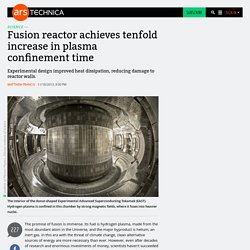
Its fuel is hydrogen plasma, made from the most abundant atom in the Universe, and the major byproduct is helium, an inert gas. In this era with the threat of climate change, clean alternative sources of energy are more necessary than ever. However, even after decades of research and enormous investments of money, scientists haven't succeeded in producing a working nuclear fusion plant. Nevertheless, many feel the potential payoff is worth continued investment. For that reason, work is proceeding apace on the next generation of fusion reactors. Nuclear fusion requires overcoming the electric repulsion between positively charged nuclei until the strong nuclear force exerts itself. Ultimately the problem is one of plasma confinement: holding the nuclei within a limited space at sufficiently high temperature.
Fusion requires temperatures greater than 15 million degrees Celsius; many reactors top 100 million degrees. Exciting MIT droplet discovery could turbocharge power plants, airships and more. Top engineers at MIT say they have come across a handy effect which could seriously boost the efficiency of a critical piece of kit used in many important technologies.
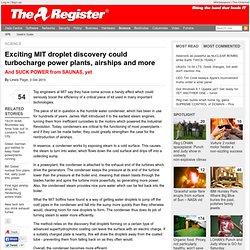
The piece of kit in question is the humble water condenser, which has been in use for hundreds of years: James Watt introduced it to the earliest steam engines, turning them from inefficient curiosities to the motors which powered the Industrial Revolution. Today, condensers are critical to the functioning of most powerplants - and if they can be made better, they could greatly strengthen the case for the reintroduction of airships. In essence, a condenser works by exposing steam to a cold surface. This causes the steam to turn into water, which flows down the cold surface and drips off into a collecting sump.
Thorium-based nuclear power. Thorium-based nuclear power is nuclear reactor-based electrical power generation fueled primarily by the fission of the isotope uranium-233 produced from the fertile element thorium.
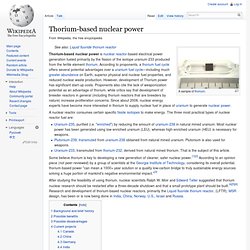
According to proponents, a thorium fuel cycle offers several potential advantages over a uranium fuel cycle—including much greater abundance on Earth, superior physical and nuclear fuel properties, and reduced nuclear waste production. However, development of Thorium power has significant start-up costs. Proponents also cite the lack of weaponization potential as an advantage of thorium, while critics say that development of breeder reactors in general (including thorium reactors that are breeders by nature) increase proliferation concerns. Since about 2008, nuclear energy experts have become more interested in thorium to supply nuclear fuel in place of uranium to generate nuclear power. A nuclear reactor consumes certain specific fissile isotopes to make energy. Uranium-235, purified (i.e. Canada[edit] China blazes trail for 'clean' nuclear power from thorium. Thorium-Fueled Automobile Engine Needs Refueling Once a Century - Industry Tap. By: David Russell Schilling | October 28th, 2013 Thorium Concept Car - Image Courtesy www.greenpacks.com There are now over one billion cars traveling roads around the world directly and indirectly costing trillions of dollars in material resources, time and noxious emissions.
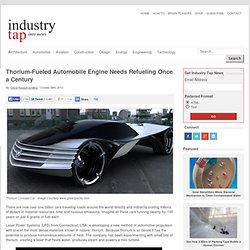
Imagine all these cars running cleanly for 100 years on just 8 grams of fuel each. Laser Power Systems (LPS) from Connecticut, USA, is developing a new method of automotive propulsion with one of the most dense materials known in nature: thorium. Because thorium is so dense it has the potential to produce tremendous amounts of heat. Cadillac World Thorium Fuel Concept (Image Courtesy www.cutedesign.com) Current models of the engine weigh 500 pounds, easily fitting into the engine area of a conventionally-designed vehicle.
The idea of using thorium is not new. According to Robert Hargraves, “low or non-CO2 emitting energy sources must be cheaper than coal or will ultimately fail to displace fossil fuels.” Norway ringing in thorium nuclear New Year with Westinghouse at the party. SHANGHAI - A privately held Norwegian company will start burning thorium fuel in a conventional test reactor owned by Norway's government with help from U.S.
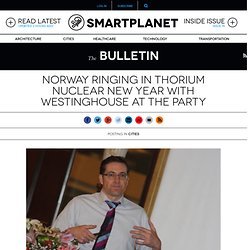
-based nuclear giant Westinghouse, the company revealed here recently. The four-year test at Norway's government owned Halden reactor could help thorium inch closer to replacing uranium as a possible safer and more effective nuclear power source. Many people believe that thorium is superior because it leaves less long- lived dangerous waste, makes it far more difficult to fashion bombs, runs more efficiently, and can be made meltdown proof. The Future of Nuclear Power Runs on the Waste of Our Nuclear Past. NASA’s cold fusion tech could put a nuclear reactor in every home, car, and plane. The cold fusion dream lives on: NASA is developing cheap, clean, low-energy nuclear reaction (LENR) technology that could eventually see cars, planes, and homes powered by small, safe nuclear reactors.

When we think of nuclear power, there are usually just two options: fission and fusion. Fission, which creates huge amounts of heat by splitting larger atoms into smaller atoms, is what currently powers every nuclear reactor on Earth. Fusion is the opposite, creating vast amounts of energy by fusing atoms of hydrogen together, but we’re still many years away from large-scale, commercial fusion reactors. (See: 500MW from half a gram of hydrogen: The hunt for fusion power heats up.) LENR is absolutely nothing like either fission or fusion.
The key to LENR’s cleanliness and safety seems to be the slow-moving neutrons.